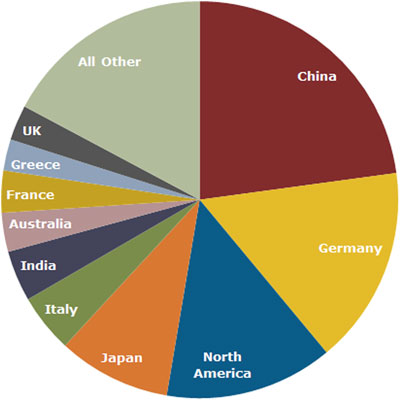| Oct 24, 2013 |
Opportunities and challenges for photovoltaic device design
|
|
(Nanowerk News) The cumulative installed photovoltaic electricity generation (PVEG) capacity exceeds 100 GW at present. It is predicted to increase to 200 GW within the next two years. The vast majority of installed PVEG systems employ traditional photovoltaic panels made of bulk silicon. PVEG systems employing solar concentrators have not made a big impact the worldwide PV scenario. Thin-film technologies have also not made a big impact yet.
|
 |
| Geographic breakdown of the PV electricity generation capacity expected to be added worldwide in 2013. (© NPD Solarbuzz)
|
|
The ongoing challenge in the PVEG industry is to decrease the overall cost of a PVEG system per peak watt generated. Several new PVEG mechanisms have been put forth. These include multiple exciton generation, carrier multiplication, and hot-carrier extraction, among others. In a survey ("Making Solar Cells a Reality in Every Home: Opportunities and Challenges for Photovoltaic Device Design") conducted by Prof. Rajendra Singh and his graduate student Githin F. Alapatt at Clemson University along with Prof. Akhlesh Lakhtakia of Penn State University, none of these mechanisms were found to be commercially viable. A few of these have not been rigorously tested.
|
|
For generating electricity very close to the location of its use, the authors concluded that only two kinds of PVEG technologies are commercially viable for terrestrial applications. The first kind employ bulk silicon. The second kind are based on thin films exemplified by amorphous silicon, cadmium telluride, and a compound semiconductor material comprising copper, indium, gallium, and selenium. Management of the flux of solar photons through the solar cells is expected to boost efficiency, but the additional manufacturing costs to be incurred thereby remain unknown.
|
|
To improve the efficiencies of these commercially viable technologies, a multi-junction multi-terminal architecture for PVEG modules appears promising. This architecture will use the currently popular bulk-silicon solar cells combined with thin-film solar cells of a semiconductor material such as copper oxide that is abundant on this planet.
|
|
“Local dc-power generation by solar PV systems coupled with the delivery and the use of dc power will making energy available for rich and poor alike," according to Singh, Alapatt, and Lakhtakia.
|


